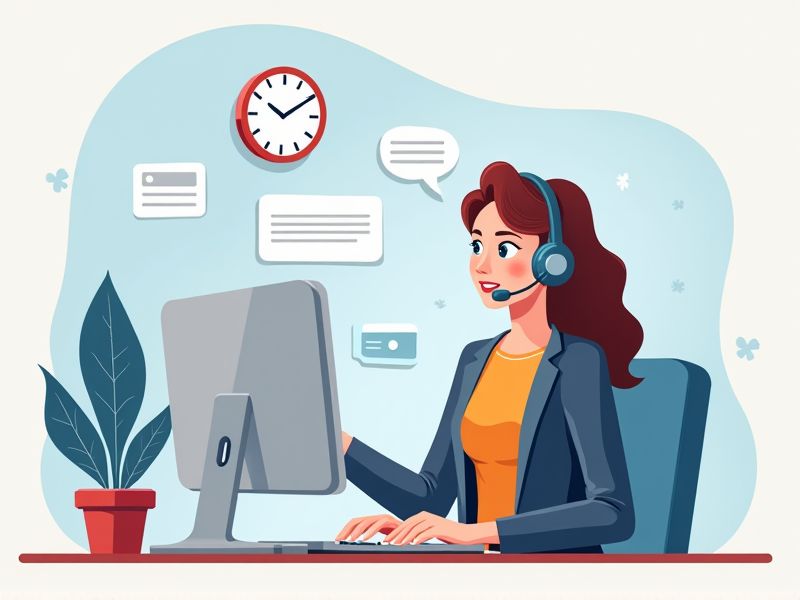
To excel in customer service, it's crucial to focus on exceeding customer expectations. As Richard Branson, founder of Virgin Group, aptly puts it, "The key is to set realistic customer expectations, and then not to just meet them, but exceed them--preferably in unexpected and helpful ways". This approach not only builds customer loyalty but also sets a company apart from its competitors. Additionally, Jeff Bezos emphasizes the importance of seamless service, stating, "The best customer service is if the customer doesn't need to call you, doesn't need to talk to you. It just works". By adopting these strategies, businesses can create a positive and memorable customer experience.
How to Be Better at Customer Service
Active Listening
Active listening starts with giving your full attention to the speaker, which minimizes misunderstandings and shows genuine care. It involves reflecting on what the customer said and asking clarifying questions, ensuring you accurately grasp their needs. This approach builds trust and rapport, driving better customer retention and satisfaction. Consistently practicing active listening leads to quicker issue resolution and a more loyal customer base.
Empathy
Developing empathy starts with active, attentive listening that allows you to understand customer concerns and feelings. When you genuinely acknowledge their emotions, you not only validate their experience but also pave the way for effective problem-solving. Data-driven insights, such as feedback surveys and sentiment analysis, can help refine your approach by identifying common emotional triggers and specific areas for improvement. By combining these insights with a sincere effort to connect with customers on a personal level, you can consistently deliver a more empathetic and satisfying service experience.
Responsiveness
Rapid response times directly improve customer satisfaction and loyalty by resolving issues before they escalate. Leveraging real-time analytics and feedback, customer service teams can identify bottlenecks and optimize response protocols. Automated tools like chatbots and streamlined ticketing systems also reduce wait times and improve agent efficiency. Consistently monitoring data and adjusting workflows ensures that responsiveness remains high even during peak demand periods.
Clear Communication
Clear communication builds trust and minimizes errors, making it easier for customer service teams to understand and meet client needs. Using simple, precise language helps clarify processes and products, reducing ambiguity and potential misunderstandings. Actively listening to customer feedback ensures that any gaps in understanding are addressed promptly, enhancing overall service delivery. Consistent, transparent communication not only improves customer satisfaction but also contributes to higher retention rates and positive reviews.
Personalized Service
Utilize customer data and feedback analysis to pinpoint each client's unique needs and preferences, ensuring that every interaction is genuinely personalized. Incorporate past purchase histories and previous interactions into each conversation, which fosters trust and a deeper customer connection. Train customer service representatives to actively listen and adapt their approach based on individual client contexts so that each interaction feels thoughtfully tailored. Finally, leveraging CRM systems to document detailed customer profiles directly bolsters efficiency and enhances long-term satisfaction.
Swift Resolution
Swift resolution is essential to customer service as it directly minimizes wait times and alleviates client frustration. Quick identification and response to issues are supported by data analysis, which pinpoints bottlenecks in current practices. Empowering representatives with the authority to make immediate decisions enhances accountability and fosters swift problem resolution. Regular collection and evaluation of feedback data ensure that resolution practices continuously evolve to meet customer expectations.
Proactive Engagement
Proactive engagement directly anticipates customer concerns, reducing friction before issues escalate. Actively reaching out with targeted communications builds trust and demonstrates a commitment to service quality. Customer feedback collected in real-time can guide continuous improvements and preempt potential challenges. Data consistently shows that proactive engagement strategies correlate with higher satisfaction rates and improved customer retention.
Consistent Follow-Up
Regular follow-up builds customer trust by showing that you genuinely care about resolving their issues. Data shows that customers who receive timely follow-ups are significantly more loyal and likely to provide positive feedback. This steady communication method not only uncovers additional concerns but also highlights potential opportunities to enhance service. Ultimately, by consistently checking in, you maintain an open dialogue that fosters a stronger and more reliable customer relationship.
Continuous Training
Continuous training equips teams with up-to-date skills that directly enhance their problem-solving abilities. Regular workshops and role-playing scenarios enable employees to handle diverse customer issues with confidence, reducing resolution times. By addressing gaps in product knowledge and communication techniques through ongoing education, customer satisfaction rates improve noticeably. Continuous training also fosters a culture of accountability and adaptability, leading to more proactive service and long-term customer retention.
Professional Demeanor
Maintaining a calm and respectful tone in every interaction instills trust in customers, reducing the likelihood of conflicts. Demonstrating empathy and active listening helps customers feel understood and valued, which boosts satisfaction. Using clear, positive language mitigates misunderstandings and guides customers effectively toward solutions. Regular training and self-evaluation refine your professional demeanor, ultimately leading to enhanced customer loyalty and overall service quality.
Summary
Active Listening ensures that every customer communication is understood clearly, allowing for tailored responses that directly address issues. Empathy creates a strong connection by validating customer feelings and effectively reducing tension during challenging interactions. Responsiveness quickly turns feedback into action, minimizing wait times and fostering a sense of reliability. Together, these practices not only enhance the quality of customer service but also build trust and long-term customer loyalty.
